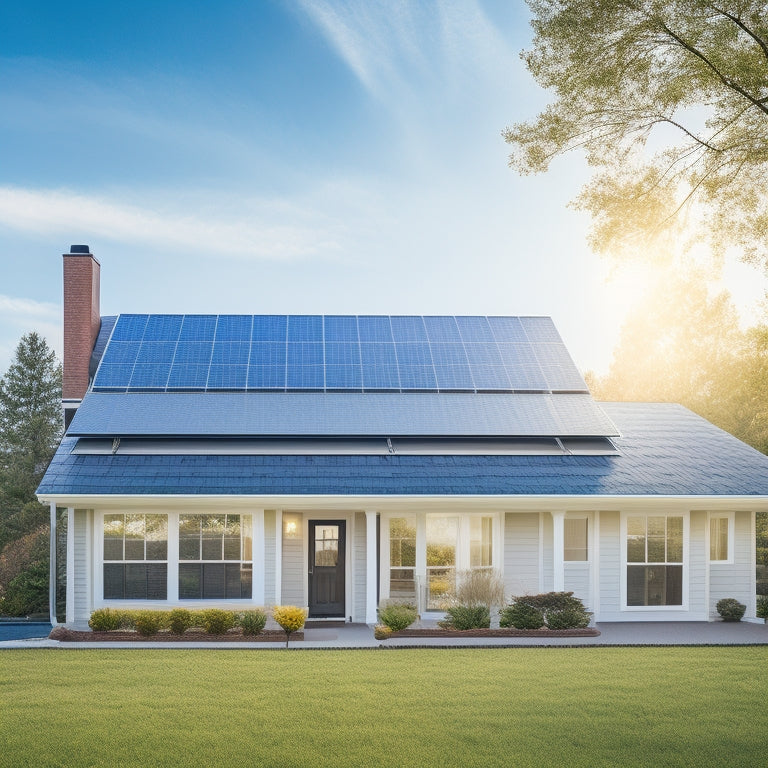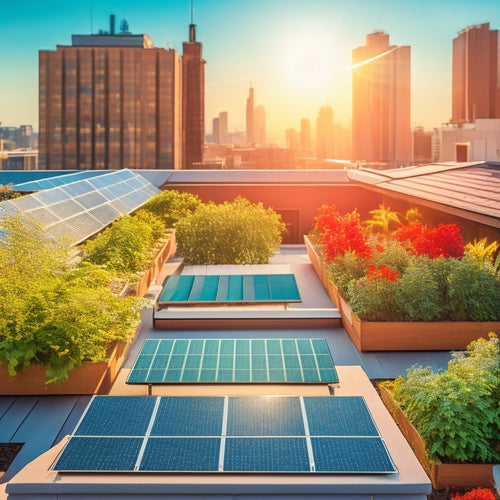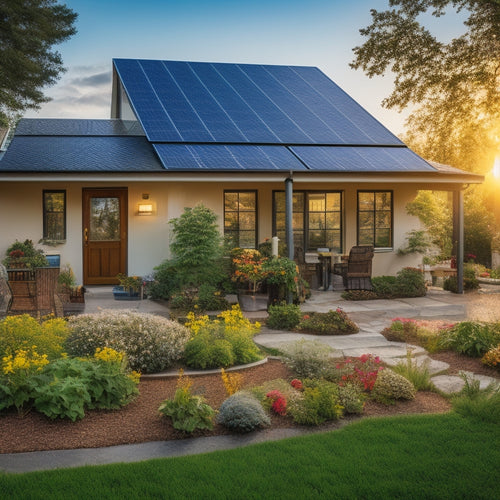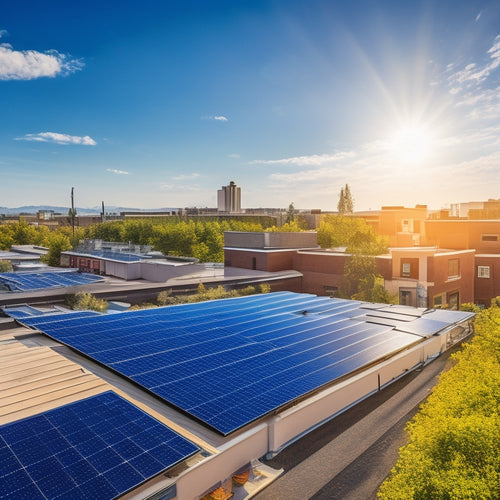
What to Consider for Home Solar System Installation
Share
When considering a home solar system installation, you'll want to assess your energy needs by analyzing your past electricity bills and calculating your daily energy consumption. You'll need to choose the right solar panel type, considering factors like efficiency ratings, degradation rates, and aesthetics. Roof orientation, structural integrity, and local building codes are also essential factors. Don't forget to research and select a reputable installer, and familiarize yourself with local regulations, incentives, and financing options. As you weigh these considerations, you'll be well on your way to a successful installation that meets your unique needs and sets you up for long-term energy savings.
Key Takeaways
- Assess your energy needs by analyzing past electricity bills and considering appliance and system efficiency to determine the required solar panel size and number.
- Choose the right solar panel type based on efficiency ratings, degradation rates, warranty, and aesthetic appeal, considering monocrystalline and polycrystalline options.
- Ensure your roof is suitable for solar installation by evaluating orientation, shading, structural integrity, and material condition, and planning for future expansions.
- Select a reputable installer certified by organizations like NABCEP, with a proven track record of successful installations and customer satisfaction.
- Research and comply with local regulations, incentives, and environmental guidelines to ensure a smooth and successful solar system installation.
Assessing Your Energy Needs
When contemplating a home solar system installation, evaluating your energy needs is the essential first step. You'll want to determine how much energy you consume daily to guarantee your solar system can meet your power requirements. Conducting a solar consumption analysis will help you identify your energy usage patterns, including peak hours, daily consumption, and seasonal variations.
To do this, gather your past electricity bills for the last 12 months to get an accurate representation of your energy usage. This data will help you calculate your total daily energy consumption in kilowatt-hours (kWh).
You'll also want to take into account the size and type of appliances, lighting, and HVAC systems in your home, as these impact your energy needs.
Understanding your energy needs will enable you to determine the size and number of solar panels required for your installation. This, in turn, will influence the system's overall cost, efficiency, and performance.
Choosing a Solar Panel Type
When choosing a solar panel type, you'll need to contemplate two key factors: panel efficiency ratings and the difference between monocrystalline and polycrystalline panels.
Panel efficiency ratings, which range from 15% to 22%, determine how much energy each panel can produce per hour of sunlight.
You'll also need to decide between monocrystalline panels, which offer higher efficiency but are more expensive, and polycrystalline panels, which are more affordable but less efficient.
Panel Efficiency Ratings
Efficiency ratings play an essential role in choosing the right solar panel type for your home solar system installation.
You want to maximize your energy output while minimizing the space required for your solar panels. Efficiency ratings help you do just that.
When evaluating panel efficiency, consider the following factors:
-
Efficiency rating: A higher rating means more energy produced per unit area. Look for panels with high efficiency ratings (above 20%) for maximum output.
-
Panel degradation: All solar panels degrade over time, but high-efficiency panels tend to degrade more slowly. This means they'll maintain their energy output longer.
-
Efficiency lifespan: Consider the warranty and expected lifespan of the panels. A longer warranty and lifespan guarantee your panels will remain efficient for years to come.
Monocrystalline Vs Polycrystalline
Take the next step in your home solar system installation by selecting the right solar panel type. When choosing between monocrystalline and polycrystalline solar panels, you'll want to evaluate several factors.
In terms of cost comparison, monocrystalline panels are generally more expensive due to the higher purity of silicon used in their production. However, they also offer higher performance metrics, converting sunlight into electricity more efficiently.
Polycrystalline panels, on the other hand, are more affordable but have slightly lower efficiency ratings.
Both options have a similar installation process, but monocrystalline panels may require more precise placement to maximize their performance.
When it comes to environmental impact, both types are eco-friendly, but monocrystalline panels have a slightly lower carbon footprint.
Longevity evaluations are also important, with monocrystalline panels typically lasting up to 30 years and polycrystalline panels lasting around 25-30 years.
Aesthetic appeal may also play a role, as monocrystalline panels tend to have a more uniform appearance.
Ultimately, your choice will depend on your specific needs, budget, and priorities.
Roof Size and Condition Matters
Your roof is a critical factor in determining the viability of a home solar system installation, and its size and condition play a significant role in the process. The roof's size will affect the number of solar panels you can install, while its condition will impact the system's overall performance and safety.
When evaluating your roof, consider the following key factors:
-
Roof orientation and shading analysis: Confirm your roof receives sufficient sunlight throughout the day, and that shading from trees or other obstructions won't impact energy production.
-
Structural integrity and installation accessibility: Verify that your roof can support the weight of the solar panels and that the installation team can access the roof safely and easily.
-
Roof material and condition: Assess the type of roofing material and its condition to determine if it's suitable for solar panel installation and can withstand the system's weight and potential weathering.
Additionally, consider your local climate and how it may affect your roof's condition over time.
It's also essential to think about future expansion or upgrades to your solar system, confirming your roof can accommodate them.
Selecting a Reputable Installer
With your roof ready for a home solar system installation, it's crucial to find a reputable installer who can guarantee a successful and efficient setup.
You'll want to research potential installers and evaluate their qualifications, experience, and customer reviews. Look for installers who are certified by reputable organizations, such as the North American Board of Certified Energy Practitioners (NABCEP). This certification guarantees they've the necessary knowledge and skills to design and install a safe and efficient solar system.
Check online review platforms, such as Yelp or Google Reviews, to see what previous customers have to say about their experience with the installer. Pay attention to the overall rating, as well as comments about the installer's communication, work quality, and customer service.
You should also ask for references from friends, family, or neighbors who've already installed solar panels. By doing your due diligence, you can find a reputable installer who'll guarantee a smooth and successful installation process, providing you with clean, renewable energy for years to come.
Understanding Local Building Codes
You'll need to verify your solar system installation meets local building codes, which involves obtaining necessary permits and passing inspections.
Code compliance requirements vary by jurisdiction, so it's crucial to familiarize yourself with local regulations to avoid costly rework or even system removal.
Permitting and Inspections
The local government's permitting process is an essential step in home solar system installation, as it guarantees that the installation meets the necessary safety and building codes.
You'll need to obtain the required permits before commencing the installation. This involves submitting your system design and plans to the local authorities for review.
During the permitting process, you'll need to evaluate the following:
-
Zoning regulations: Verify your system complies with local zoning laws, including setbacks, height restrictions, and other requirements.
-
Inspection processes: Schedule and pass inspections at various stages of the installation to confirm compliance with building codes and safety standards.
-
Building code compliance: Validate that your system meets local building codes, including electrical and fire safety codes.
Code Compliance Requirements
Once you've obtained the necessary permits, your focus shifts to guaranteeing your home solar system installation meets local building codes.
This involves complying with a range of regulations that dictate how your system is designed, installed, and operates. Safety regulations, for instance, cover aspects like electrical shock protection and fire hazards.
Electrical codes outline specific requirements for wiring, grounding, and connections. Environmental guidelines may address issues like panel placement, land use, and wildlife habitats.
Zoning laws regulate the placement of solar panels, making sure they don't obstruct views or compromise neighborhood aesthetics.
Installation standards dictate the quality of materials, workmanship, and testing procedures. Interconnection requirements specify how your system connects to the grid, assuring seamless and safe energy transfer.
Incentives and Financing Options
Government-backed incentives and lucrative financing options can greatly reduce the upfront cost of installing a home solar system, making it more accessible and affordable for homeowners like you.
To take advantage of these incentives, consider the following options:
-
Federal Tax Credits: You can claim a federal tax credit of up to 26% of the total cost of your solar system installation.
-
State Rebates and Incentives: Many states offer additional rebates and incentives for homeowners who install solar systems, which can further reduce the upfront cost.
-
Financing Options: You can examine financing options such as solar loans, lease agreements, and power purchase agreements, which can help spread the cost of installation over time.
Additionally, you may be eligible for energy efficiency programs or community solar initiatives that can provide further discounts and benefits.
Energy Storage and Backup Plans
Two key factors for homeowners shifting to solar power are energy storage and backup plans. As you investigate solar energy, you'll want to reflect on how to store excess energy generated by your system during the day for use during the night or on cloudy days. This is where battery technology comes in.
With advancements in battery technology, you can store energy and use it when you need it, reducing your reliance on the grid.
Grid independence is a major benefit of energy storage. By storing excess energy, you can power your home even when the grid is down. This is especially important for homeowners who live in areas prone to natural disasters or frequent power outages.
When choosing a battery solution, evaluate factors such as capacity, depth of discharge, and warranty. You'll also want to examine your backup plan in case of an extended power outage. Will you rely on a generator or a battery bank?
Having a solid energy storage and backup plan in place will guarantee you have power when you need it most.
Maintenance and Monitoring Requirements
As you start to produce clean energy with your home solar system, it's essential to take into account the ongoing maintenance and monitoring needs to guarantee peak performance and longevity.
Neglecting these requirements can lead to reduced energy output, system failures, and even safety hazards.
To make certain your system operates at its best, consider the following:
- Regular Cleaning: Develop a cleaning schedule to remove dirt, debris, and snow that can obstruct energy production.
Employ effective cleaning techniques, such as soft-bristled brushes or specialized cleaning solutions, to prevent panel damage.
- Performance Monitoring: Implement a monitoring system to track your energy production, consumption, and system performance.
This allows you to identify potential issues early on and make data-driven decisions to optimize your system.
- Scheduled Inspections: Schedule regular inspections with certified professionals to identify and address potential issues before they become major problems.
This includes inspecting electrical connections, inverters, and mounting systems to make sure they're functioning correctly and safely.
Frequently Asked Questions
Can I Install Solar Panels on a Metal or Clay Tile Roof?
You can install solar panels on a metal or clay tile roof, but you'll need to choose compatible roofing materials and adapt installation methods to guarantee a secure and watertight seal, avoiding damage to your roof.
Do Solar Panels Work During Power Outages?
You'll find that solar panels don't provide power during outages with traditional grid-tied systems, as they're designed to shut down for safety reasons. However, you can opt for battery-backed systems to maintain solar panel efficiency during power outages.
Are Solar Panels Resistant to Hail and Extreme Weather?
You'll be relieved to know that most solar panels are designed with hail resistance in mind, and can withstand extreme weather conditions, including heavy rain, strong winds, and even golf-ball-sized hail, ensuring your power supply remains uninterrupted.
Can I Add Solar Panels to My Existing Electrical Panel?
You'll need to guarantee your existing electrical panel can handle the added solar panel load; if not, you'll require electrical panel upgrades to achieve solar panel compatibility, securing a safe and efficient connection.
Will Solar Panels Affect My Homeowners' Insurance Premiums?
A million questions are running through your mind, but let's tackle the big one: will solar panels impact your homeowners' insurance premiums? Short answer: probably, but not drastically. You may see premium adjustments, depending on your provider's solar insurance policies, but it's typically a small increase.
Conclusion
You've finally made it to the finish line, and yet, your home solar system installation expedition is just beginning. Ironically, the most critical part of the process starts after the panels are installed - maintaining and monitoring your system to guarantee peak performance. Don't get too comfortable; stay vigilant and keep track of your energy production to reap the full benefits of going solar.
Related Posts
-

Solar System Installation Rebates and Tax Credits
Solar system installations offer beneficial rebates and tax credits that greatly cut your initial costs. You can bene...
-

How to Achieve Energy Independence at Home
To achieve energy independence at home, start by investing in renewable energy sources like solar panels, wind turbin...
-

Solar Energy Solutions for Small Businesses
Switching to solar energy can be a game changer for your small business. You'll enjoy significant cost savings on mon...


